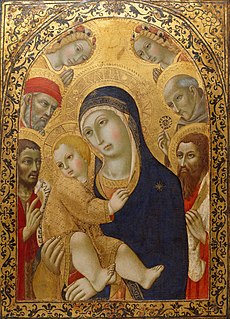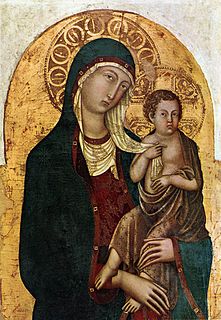
Duccio di Buoninsegna was an Italian painter active in Siena, Tuscany, in the late 13th and early 14th century. He was hired throughout his life to complete many important works in government and religious buildings around Italy. Duccio is considered one of the greatest Italian painters of the Middle Ages, and is credited with creating the painting styles of Trecento and the Sienese school. He also contributed significantly to the Sienese Gothic style.

Guido Reni was an Italian painter of the Baroque period, although his works showed a classical manner, similar to Simon Vouet, Nicolas Poussin, and Philippe de Champaigne. He painted primarily religious works, but also mythological and allegorical subjects. Active in Rome, Naples, and his native Bologna, he became the dominant figure in the Bolognese School that emerged under the influence of the Carracci.

Guido of Siena, was an Italian painter, active during the 13th-century in Siena, and painting in an Italo-Byzantine style.

Sano di Pietro or Ansano di Pietro di Mencio (1405–1481) was an Italian painter of the Sienese school of painting. He was active for about half a century during the Quattrocento period, and his contemporaries included Giovanni di Paolo and Sassetta.

Segna di Bonaventura, also known as Segna de Bonaventura, and as Segna di Buonaventura, was an Italian painter of the Sienese School. He was active from about 1298 to 1331. In 1306 he painted a panel for the office of the Biccherna in the Palazzo Pubblico in Siena. In 1317 he painted an altar panel for the convent of Lecceto. In 1319 he repaired a figure of the Virgin in the Palazzo Pubblico. In 1321 he painted a panel for the Palazzo Pubblico. Segna di Bonaventura’s sons Niccolò di Segna and Francesco di Segna di Bonaventura were also painters of the Sienese School

Lippo Memmi was an Italian painter from Siena. He was the foremost follower of Simone Martini, who was his brother-in-law.

Astolfo Petrazzi (1583–1665) was an Italian painter of the Baroque period, active mainly in his hometown of Siena, but also Spoleto and Rome. He was a pupil of mainly Francesco Vanni, but also worked under Ventura Salimbeni and Pietro Sorri. He died in Siena.

Neroccio di Bartolomeo de' Landi (1447–1500) was an Italian painter and sculptor of the early-Renaissance or Quattrocento period in Siena.

Naddo Ceccarelli was a 14th-century Italian painter of the Sienese School.

The Pinacoteca Nazionale is a national museum in Siena, Tuscany, Italy. Inaugurated in 1932, it houses especially late medieval and Renaissance paintings from Italian artists. It is housed in the Brigidi and Buonsignori palaces in the city's center: the former, built in the 14th century, it is traditionally identified as the Pannocchieschi family's residence. The Palazzo Bichi-Buonsignori, although built in the 15th century, has a 19th-century neo-medieval façade based on the city's Palazzo Pubblico.

The Rucellai Madonna is a panel painting representing the Virgin and Child enthroned with Angels by the Sienese painter Duccio di Buoninsegna. The original contract for the work is dated 1285; the painting was probably delivered in 1286. The painting was commissioned by the Laudesi confraternity of Florence to decorate the chapel they maintained in the Dominican church of Santa Maria Novella. It was transferred to the Galleria degli Uffizi in the 19th century. The Rucellai Madonna is the largest 13th-century panel painting extant.

Niccolò di Segna was an Italian painter from Siena. His activity is documented starting from 1331.

Master of Città di Castello, in Italian, Maestro di Città di Castello, was an anonymous painter of Medieval art. Mason Perkins is responsible for his identification and naming in 1908, based on the styling from the Master preserved at the Pinacoteca comunale, Città di Castello, in Umbria.

Andrea di Niccolò, also Andrea di Niccolò di Giacomo, (1440–1514) was an Italian painter of the Sienese School.

Guidoccio Cozzarelli (1450–1517) was an Italian Renaissance painter and miniaturist.
Antonio or Antonio d'Ariodante Buonfigli was an Italian painter of the late-Baroque period.

The Museo Civico di Montepulciano, also known as the Museo Civico Pinacoteca Crociani, is the town or comune art gallery and museum. It is housed in the medieval Palazzo Neri Orselli, a 14th-century structure located on Via Ricci #10, corner with Via Talosa, in the center of the town of Montepulciano, in the Province of Siena, region of Tuscany, Italy. The museum was founded in 1954.

The Pinacotecta Nazionale is an art gallery in Ferrara, Emilia-Romagna, Italy. It is located on the piano nobile of the Palazzo dei Diamanti, a work of Renaissance architecture by Biagio Rossetti, commissioned by Leonello d’Este in 1447. Not to be confused with the Civic Museum on the lower floor, which has hosted temporary exhibitions of contemporary art since 1992, the Pinacoteca houses a collection of paintings by the Ferrarese School dating from the thirteenth to the eighteenth centuries. It was founded in 1836 by the Municipality of Ferrara after Napoleon's widespread dissolution of churches threatened the protection of important public artworks. The gallery is formed as much around notable northern Italian painters as it is around the exquisite interior decoration of the palace itself, together with remnants of frescoes from local churches and later acquisitions from the Sacrati Strozzi collection.

Pietro di Giovanni D'Ambrogio (fl.1410-1449) was an Italian painter of the Sienese school.
Enzo Carli was an Italian art historian and art critic.





















